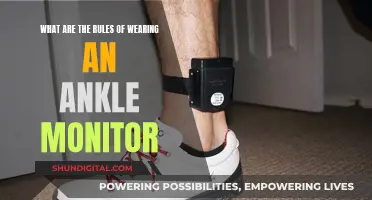
Blind spot monitors are an advanced driver assistance system (ADAS) designed to increase safety by alerting the driver to vehicles that may be in their blind spot. Blind spots are areas on either side of a car that the driver cannot see when looking into the rearview or side-view mirrors. This technology helps prevent drivers from colliding with another vehicle moving alongside them in an adjacent lane. Blind spot monitors use radar or ultrasonic sensors, as well as cameras in the side-view mirror housings, to detect vehicles in these blind spots. They then alert the driver through visual, audible, or haptic warnings. While not a substitute for checking mirrors and looking over one's shoulder, blind spot monitors offer an added safety measure to reduce the occurrence of lane-change crashes and compensate for human error.
| Characteristics | Values |
|---|---|
| Purpose | To increase safety by alerting the driver to vehicles that may have escaped visibility in the side-view mirrors |
| Detection | Radar, ultrasonic sensors, sonar, lidar, cameras |
| Activation | Speeds greater than 20 mph |
| Alerts | Visual, audible, haptic |
| Control | Control panel button, driver interface command in the vehicle’s infotainment system |
| Installation | Professional, DIY |
| Cost | $300-$500 for a solid system |
What You'll Learn

How blind spot monitors work
Blind spot monitors are vehicle-based sensor devices that detect other vehicles located in the driver's side and rear blind spots. They are designed to alert the driver of potential hazards that they might not be able to see, such as vehicles in adjacent lanes that are difficult to spot using mirrors alone.
Blind spot monitoring systems typically use a combination of sensors and sometimes side-mounted cameras to track approaching traffic in adjoining lanes. The sensors are usually embedded in each side of the vehicle's rear bumper and can detect vehicles using radar, ultrasonic sensors, sonar, or lidar technology. More advanced systems may also employ cameras inserted into the side mirrors.
Once the system detects an approaching vehicle, it triggers a warning to alert the driver. This warning can take various forms, including visual indicators (such as a yellow warning light on the side mirror or the vehicle's A-pillar), audible alerts, or even tactile feedback such as vibrating seats or steering wheels. Some systems may also provide steering assistance, nudging the driver back towards the centre of the lane or applying brake pressure to avoid a potential collision.
Blind spot monitors are designed to work in conjunction with proper mirror adjustment and safe driving practices. They are not meant to replace the need for drivers to actively check their mirrors and surroundings but rather to provide an additional layer of safety and reduce the risk of accidents, especially when changing lanes or merging.
Monitoring Contractions: What to Look For and How to Prepare
You may want to see also

Benefits of blind spot monitors
Blind-spot monitoring (BSM) is a driver aid that helps to prevent accidents by alerting the driver to vehicles in their blind spot. The system uses sensors and sometimes cameras to detect vehicles in the driver's blind spot and then alerts the driver through visual or audio cues.
Increased Driving Awareness
The system constantly views spots that the driver can't always track while driving, providing extra coverage and increasing driving awareness.
Assists Drivers of Larger Vehicles
Blind-spot monitoring is especially useful for larger vehicles, which have bigger blind spots. The monitor can reduce stress levels by showing drivers the areas surrounding their vehicle that they can't see.
Prevents Crashes
By tracking the area around the vehicle, blind-spot monitoring can prevent drivers from merging into another vehicle in the same direction or an adjoining lane.
Increases Response Time
Blind-spot monitoring systems are more accurate than mirrors, allowing drivers to recognize potential dangers faster and increasing the time to respond.
Relieves Stress of Driving in Close Quarters
The early warning system increases the driver's response time and relieves some of the stress of driving in close quarters.
Studio Monitor Blown: How to Spot the Signs
You may want to see also

Types of blind spot monitoring systems
Blind-spot monitoring systems (BSM) are safety devices that detect vehicles or obstacles in a driver's blind spots, alerting the driver to potential hazards. There are two main types of BSM systems:
- Radar-based systems: These systems use advanced radio frequency technology to detect vehicles in adjacent lanes that may be outside the driver's direct line of sight. Radar-based systems provide real-time information on the proximity and speed of nearby vehicles, aiding in safe lane changes. They are also effective in various weather conditions, such as rain or fog, ensuring reliability in compromised visibility situations.
- Camera-based systems: Camera-based BSM systems employ high-resolution cameras to capture a comprehensive view of the vehicle's surroundings and analyse blind spots with precision. In addition to detecting nearby vehicles, these systems can also recognize pedestrians, cyclists, and other potential hazards, providing a more comprehensive safety solution.
Some BSM systems combine both radar and camera technologies, creating a comprehensive safety shield around the vehicle and enhancing overall situational awareness.
Additionally, there are aftermarket blind spot monitoring systems available for older vehicles that may not have factory-installed technology. These systems typically use sensors and indicators to alert drivers of potential hazards.
Monitor Home Energy and Gas Usage: Save Money, Save Planet
You may want to see also

How to install a blind spot monitor
Blind-spot monitoring (BSM) is a safety feature that can be added to a van or any other vehicle to increase the driver's awareness and prevent accidents. It is especially useful for larger vehicles that tend to have bigger blind spots.
If you are looking to install a blind spot monitor on your van, you can choose to have it professionally installed or do it yourself. Here is a step-by-step guide on how to install an aftermarket blind spot monitor yourself:
Step 1: Prepare the Calibration
Place a measuring tape parallel to your van's wheels. Take the calibration cloth from your system and place it behind the vehicle, aligning it with the measuring tape at a 90-degree angle. Use a level to create a vertical line against the vehicle, aligning it with the calibration cloth as well. Mark a straight line on the rear bumper of your van with a marker.
Step 2: Remove and Clean Necessary Parts
Remove the rear bumper of your van. You may also need to remove the taillights. Clean the calibrating positions on the inner rear bumper with a cleaning cloth and rubbing alcohol.
Step 3: Position the Magnets
Take the two magnets included in the system. Place one magnet on the outside of the van, along the line you marked in Step 1. Place the other magnet inside the van so that they attract each other. Play around with the placement of the sensors to find the optimal angle, which is usually around 20 degrees from the bumper. Mark the spot inside the bumper where the magnet rests.
Step 4: Install the Sensors
Apply adhesive to the sensors and stick them onto the marked spots inside the bumper.
Step 5: Mount the Indicators
Mount the LED indicators inside the cabin of your van. Place them in a location that is easily visible without taking your eyes off the road. Refer to your kit's recommendations for optimal placement.
Step 6: Test the System
Adjust the volume of the indicators to ensure it is at a suitable level. Test the system to make sure it functions properly.
If you encounter any issues or have questions during the installation process, it is recommended to reach out to a service centre for professional assistance.
It is important to note that blind spot monitors are not a substitute for properly adjusting your mirrors and physically checking your blind spots while driving. They serve as an additional safety feature to enhance your awareness and reduce the risk of accidents.
Blind Spot Monitor: Is It Available on Honda Civic?
You may want to see also

History of blind spot monitors
Blind spot monitors are now a common feature in modern cars, but they were once a novelty reserved for premium and luxury vehicles. The technology was first conceptualised by George Platzer, who believed that adjusting side-view mirrors correctly could minimise the dangers of blind spots. Platzer presented this idea to Ford, claiming it was "an elegant and relatively inexpensive solution" to the problem of blind spots. However, this method proved challenging for many drivers to execute correctly, and inexperienced drivers often found themselves in even more danger.
The first implementation of a blind spot detection system was in the 2001 Volvo SCC concept car, which featured a BLIS (Blind Spot Information System) that used cameras and radar sensors to detect vehicles in the blind spot. However, the BLIS system was removed from production in 2001 and was instead implemented in the Volvo XC90 SUV in 2003. The BLIS system produced a visual alert when a car entered the driver's blind spot while they were switching lanes. Volvo was recognised for this innovation, receiving the AutoCar Safety and Technology award.
Following Volvo's lead, several other car manufacturers began to adopt blind spot monitoring technology. Mazda introduced a blind spot monitor in their 2008 Mazda CX-9, setting the standard for Japanese car manufacturers. They refer to the system as BSM (Blind Spot Monitoring). Ford, who had originally been pitched the idea, began integrating blind spot detection systems into their cars in 2009, starting with the Ford Fusion and Hybrid. Mitsubishi was a later adopter of the technology, including it in their 2016 Pajero Sport.
Today, blind spot monitors have become even more advanced, utilising radar-based sensors that are weather-resistant and highly effective in detecting nearby vehicles. These sensors emit millimetre waves to detect objects within a range of up to 10 feet behind the vehicle's bumper. The alerts produced by these systems are also more sophisticated, combining visual warnings with audible alerts to ensure drivers are aware of potential dangers.
Hooking Up Your NEC Monitor: A Step-by-Step Guide
You may want to see also
Frequently asked questions
Blind spot monitors are advanced driving assistance systems (ADAS) designed to increase safety by alerting the driver to vehicles that may be in their blind spot.
Blind spot monitors use radar or ultrasonic sensors located in the rear bumper, as well as cameras in the side-view mirror housings, to detect vehicles in the blind spot. When a vehicle is detected, the driver is alerted through a combination of visual, audible, or haptic warnings.
Blind spot monitors offer an added layer of safety by compensating for human error and reducing the risk of lane-change crashes. They can also increase driving awareness and provide early warnings, giving the driver more time to respond.
Blind spot monitors can be purchased as aftermarket kits, with prices ranging from $300 to $500 for a solid system. The installation cost for an aftermarket system is typically around $200, but it can vary depending on the location and complexity of the installation.







